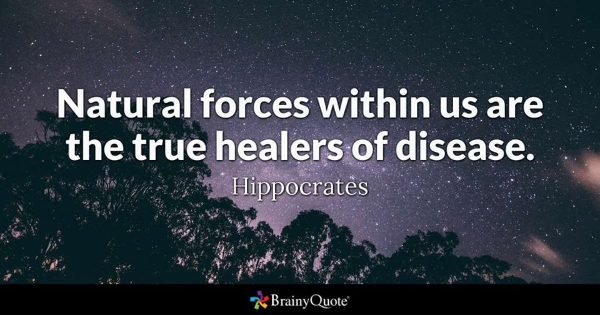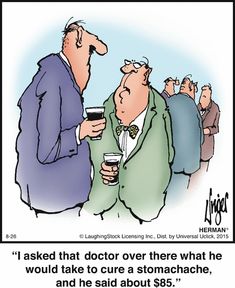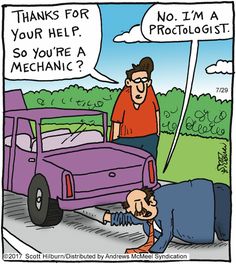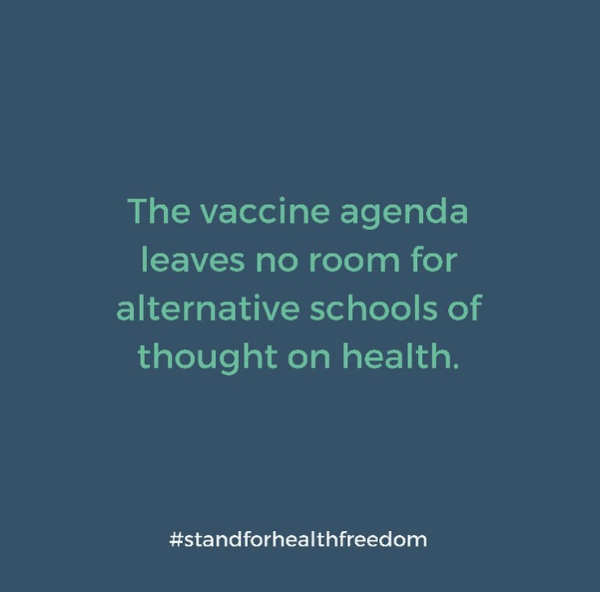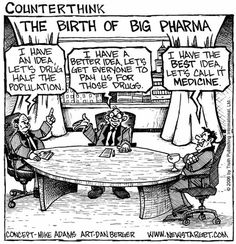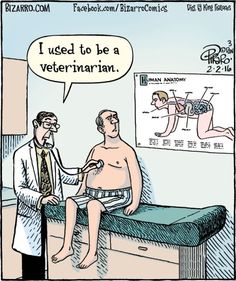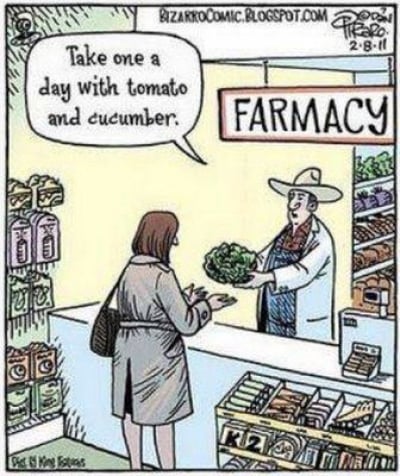I like the dark skin grapes too, wish I had room to grow themI haven't tried it, but I like dark skinned grapes tho....
Become a Patron!
You are using an out of date browser. It may not display this or other websites correctly.
You should upgrade or use an alternative browser.
You should upgrade or use an alternative browser.
Jimi's Daily Health Articles
- Thread starter Jimi
- Start date
Good video Dale Thanks for posting it my friend
Cancer and Poor Diet: New Cancer Diagnoses Every Year
https://drpompa.com/fasting-diet/ca...icle-PublicAC-11619&utm_campaign=HealthSecret
https://drpompa.com/fasting-diet/ca...icle-PublicAC-11619&utm_campaign=HealthSecret
7 of the Most Important Steps to Prevent Osteoporosis
https://yurielkaim.com/steps-to-prevent-osteoporosis/
https://yurielkaim.com/steps-to-prevent-osteoporosis/
DIY Herbal Cleaning Spray
Ingredients:
1 cup distilled water
1 cup white vinegar
20 drops tea tree essential oil
20 drops lemon essential oil
Instructions:
- Slowly mix all ingredients together in a spray-nozzle bottle. Shake well.
- Spray on any surface that needs a good cleaning
- Scrub scrub scrub!
*I strongly suggest making this batch fresh each week. Since the ingredients are all-natural, they have a shorter shelf life.
Ingredients:
1 cup distilled water
1 cup white vinegar
20 drops tea tree essential oil
20 drops lemon essential oil
Instructions:
- Slowly mix all ingredients together in a spray-nozzle bottle. Shake well.
- Spray on any surface that needs a good cleaning
- Scrub scrub scrub!
*I strongly suggest making this batch fresh each week. Since the ingredients are all-natural, they have a shorter shelf life.
Do genetically modified crops really produce greater yields than those that are grown traditionally? An article published in the New York Times says no, and offers solid proof to back that up.
Despite promises and claims made by Monsanto, a careful analysis of the statistics and a comparison of the course of agriculture in countries using GMOs and those using traditional methods shows that genetically modified crops not only fail to increase crop yield, countries using them actually lag behind the production of those who don’t.
The article points out that in the United States and Canada, where genetically modified crops are grown, crop yields have “gained no discernible advantage in yields” while countries in Europe (where GMOs are not grown) have seen growth. The article includes a variety of graphs that clearly display the discrepancy.
“An analysis by The Times using United Nations data showed that the United States and Canada have gained no discernible advantage in yields—food per acre—when measured against Western Europe, a region with comparably modernized agricultural producers like France and Germany.” –Doubts about the Promised Bounty of Genetically Modified Crops, Danny Hakim for the New York Times
The results of the investigation showed that there was either no increase in crop yield when compared to yields in traditionally grown European crops, or the yield in GMO crops was less than in traditional.
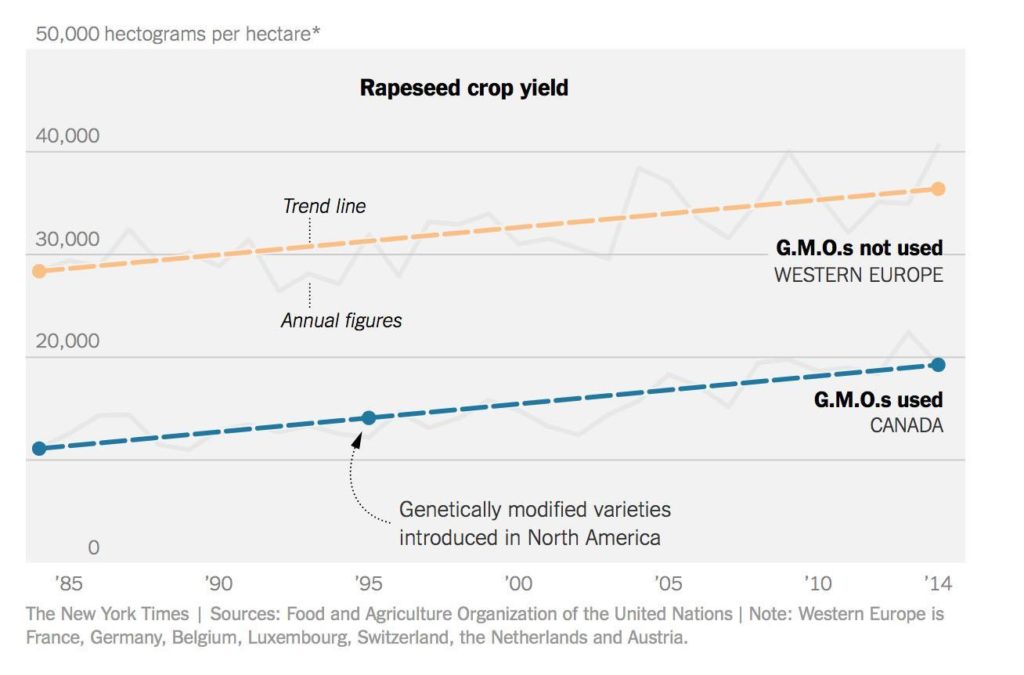
For example, corn is the number one crop in the US, and 88% of corn grown in America is genetically modified. Still, a study done by the International Journal of Agricultural Sustainability showed that Eastern Europe’s non-GMO crops are yielding slightly better than ours. And in some cases (for example sugar beets), a notable lack of increase, when compared to Europe’s crops, has been shown—putting the US considerably behind Europe in its agricultural production.
Another point to keep in mind is that GMOs, even if they were increasing yields at the rate they claimed they would, are not meant to be more prolific than regular crops. This means that they do not increase yields by the seeds themselves producing more or better plants. Instead, the increase is supposed to be due to less crop loss.
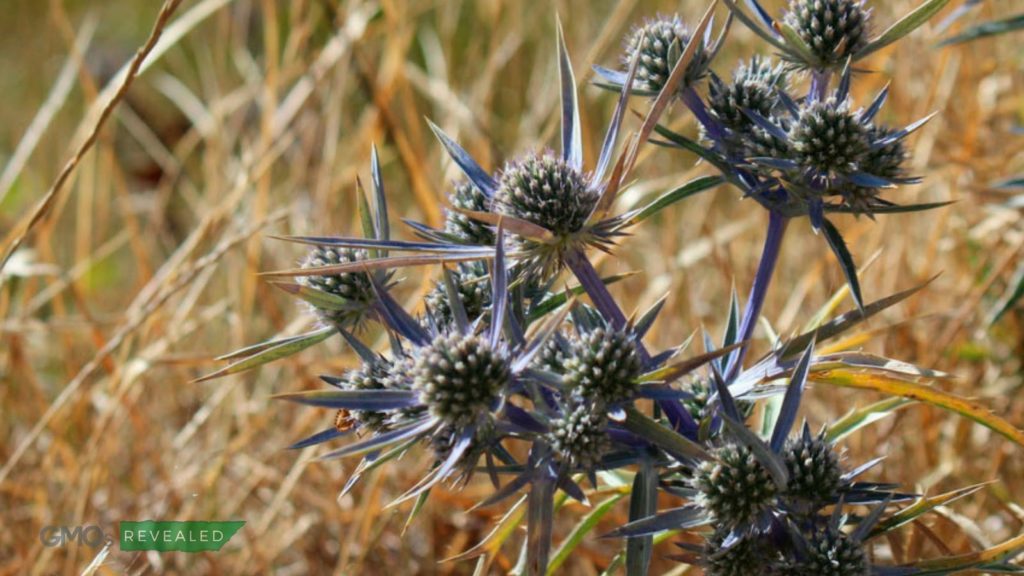
Crop loss occurs when natural pests and weeds kill or damage plants. Genetically modified corn, for example, is supposed to raise yields by resisting pests—a feature that Monsanto built-in by splicing a toxin-producing gene into its seeds. Another tactic is creating crops that “resist” Roundup, allowing weeds to be killed in the field without damaging the modified plants.
One of the reasons that GMOs are not producing the yields that they promised is that nature is designed to change and evolve in order to keep up with the environment. That means that pests can develop resistance to the toxins in genetically modified corn, and plants can develop resistance to weed killer. This means that as resistance increases, in order to maintain the promised increased yield more and more chemical pesticides and herbicides must be applied to crops. This is expensive for farmers, terrible for the environment, and dangerous for consumers.
Monsanto made promises about crop yields that they have not been able to keep—and they are still claiming that their products benefit the world by creating more food for less money. Instead, GMO crops are failing to deliver the positive effects they promised, falling short of their claims to help farmers while exacting a high environmental and health cost from the rest of us. Despite the mounting evidence that GMOs are causing more harm than good, companies like Monsanto are still influencing what the public sees when it comes to information about genetically modified crops and the chemicals used on them. The public deserves to know the truth.
Despite promises and claims made by Monsanto, a careful analysis of the statistics and a comparison of the course of agriculture in countries using GMOs and those using traditional methods shows that genetically modified crops not only fail to increase crop yield, countries using them actually lag behind the production of those who don’t.
The article points out that in the United States and Canada, where genetically modified crops are grown, crop yields have “gained no discernible advantage in yields” while countries in Europe (where GMOs are not grown) have seen growth. The article includes a variety of graphs that clearly display the discrepancy.
“An analysis by The Times using United Nations data showed that the United States and Canada have gained no discernible advantage in yields—food per acre—when measured against Western Europe, a region with comparably modernized agricultural producers like France and Germany.” –Doubts about the Promised Bounty of Genetically Modified Crops, Danny Hakim for the New York Times
The results of the investigation showed that there was either no increase in crop yield when compared to yields in traditionally grown European crops, or the yield in GMO crops was less than in traditional.

For example, corn is the number one crop in the US, and 88% of corn grown in America is genetically modified. Still, a study done by the International Journal of Agricultural Sustainability showed that Eastern Europe’s non-GMO crops are yielding slightly better than ours. And in some cases (for example sugar beets), a notable lack of increase, when compared to Europe’s crops, has been shown—putting the US considerably behind Europe in its agricultural production.
Another point to keep in mind is that GMOs, even if they were increasing yields at the rate they claimed they would, are not meant to be more prolific than regular crops. This means that they do not increase yields by the seeds themselves producing more or better plants. Instead, the increase is supposed to be due to less crop loss.

Crop loss occurs when natural pests and weeds kill or damage plants. Genetically modified corn, for example, is supposed to raise yields by resisting pests—a feature that Monsanto built-in by splicing a toxin-producing gene into its seeds. Another tactic is creating crops that “resist” Roundup, allowing weeds to be killed in the field without damaging the modified plants.
One of the reasons that GMOs are not producing the yields that they promised is that nature is designed to change and evolve in order to keep up with the environment. That means that pests can develop resistance to the toxins in genetically modified corn, and plants can develop resistance to weed killer. This means that as resistance increases, in order to maintain the promised increased yield more and more chemical pesticides and herbicides must be applied to crops. This is expensive for farmers, terrible for the environment, and dangerous for consumers.
Monsanto made promises about crop yields that they have not been able to keep—and they are still claiming that their products benefit the world by creating more food for less money. Instead, GMO crops are failing to deliver the positive effects they promised, falling short of their claims to help farmers while exacting a high environmental and health cost from the rest of us. Despite the mounting evidence that GMOs are causing more harm than good, companies like Monsanto are still influencing what the public sees when it comes to information about genetically modified crops and the chemicals used on them. The public deserves to know the truth.
Healthy sunlight exposure boosts gut health in vitamin D deficient people
https://www.naturalhealth365.com/sunlight-exposure-gut-health-3180.html
https://www.naturalhealth365.com/sunlight-exposure-gut-health-3180.html
Oral Bacteria: Bugs in Your Mouth!
https://quirkyhealthtips.com/gut-health/oral-bacteria-bugs-in-your-mouth/
https://quirkyhealthtips.com/gut-health/oral-bacteria-bugs-in-your-mouth/
I’m excited to be starting a new series on some of the naturopathic ways I help patients address the most common side effects of traditional cancer treatments.
Today’s topic is focused on fatigue.
Treatment related cancer fatigue could be a long term and far reaching side effects from chemotherapy, radiation, and surgery. Naturopathic medicine can help reduce fatigue and get your body back on track.
Here’s 5 quick tips on some of my favorite natural ways to help reduce cancer fatigue.
Get some Acetyl-L-Carnitine.
Acetyl-L-Carnitine is an amino acid that is used to create energy in every cell of your body. During the process of cancer treatment, this important amino acid is frequently depleted.
Exercise.
Although it might be difficult to get moving when you are tired, the research shows us over and over again that exercise may be one of the best remedies. Based on these studies, 30 minutes of light aerobic exercise daily may reduce fatigue. Don’t push yourself too much, and start slowly. It does not matter how long you exercise each time, but the total minutes by the end of the day is important. That means you can walk for 5 minutes 6 times a day to get a total of 30 minutes of exercise, or you can do 30 minutes all at once. If you have questions, please talk about this with a physician.
Try natural sleep aids.
Fatigue may also be due to disrupted sleep, or difficulty sleeping. If you are having difficulty sleeping there are several natural sleep aids that a naturopathic physician might recommend including homeopathy, herbs, flower essences, and nutrients. Every person’s sleep difficulties are different and deserve a unique approach.
Maintain your weight.
If you are experiencing weight loss this may be a source of your fatigue. When working to maintain your weight, it is important to work with someone that can help with meal planning, provide recipes, and discuss strategies for maintaining weight. We love providing cooking techniques, tips, and tricks for weight maintenance.
Manage stress.
Another source of fatigue may be depression. If you are experiencing emotional distress due to your cancer diagnosis, financial stress, or family role changes, we are here to support you. Several natural therapies including homeopathy, herbs, nutrients, and mind-body exercises can help reduce depression and improve your stress response.
We’ll also be discussing some natural ways to treat chemo induced nausea so stay tuned!
Today’s topic is focused on fatigue.
Treatment related cancer fatigue could be a long term and far reaching side effects from chemotherapy, radiation, and surgery. Naturopathic medicine can help reduce fatigue and get your body back on track.
Here’s 5 quick tips on some of my favorite natural ways to help reduce cancer fatigue.
Get some Acetyl-L-Carnitine.
Acetyl-L-Carnitine is an amino acid that is used to create energy in every cell of your body. During the process of cancer treatment, this important amino acid is frequently depleted.
Exercise.
Although it might be difficult to get moving when you are tired, the research shows us over and over again that exercise may be one of the best remedies. Based on these studies, 30 minutes of light aerobic exercise daily may reduce fatigue. Don’t push yourself too much, and start slowly. It does not matter how long you exercise each time, but the total minutes by the end of the day is important. That means you can walk for 5 minutes 6 times a day to get a total of 30 minutes of exercise, or you can do 30 minutes all at once. If you have questions, please talk about this with a physician.
Try natural sleep aids.
Fatigue may also be due to disrupted sleep, or difficulty sleeping. If you are having difficulty sleeping there are several natural sleep aids that a naturopathic physician might recommend including homeopathy, herbs, flower essences, and nutrients. Every person’s sleep difficulties are different and deserve a unique approach.
Maintain your weight.
If you are experiencing weight loss this may be a source of your fatigue. When working to maintain your weight, it is important to work with someone that can help with meal planning, provide recipes, and discuss strategies for maintaining weight. We love providing cooking techniques, tips, and tricks for weight maintenance.
Manage stress.
Another source of fatigue may be depression. If you are experiencing emotional distress due to your cancer diagnosis, financial stress, or family role changes, we are here to support you. Several natural therapies including homeopathy, herbs, nutrients, and mind-body exercises can help reduce depression and improve your stress response.
We’ll also be discussing some natural ways to treat chemo induced nausea so stay tuned!
https://www.greenmedinfo.health/blog/cancer-now-leading-cause-death?utm_campaign=Daily Newsletter: Cancer is Now the Leading Cause of Death (PYA7Wh)&utm_medium=email&utm_source=Daily List&_ke=eyJrbF9lbWFpbCI6ICJqaW1tY2NhcnR5MjhAeWFob28uY29tIiwgImtsX2NvbXBhbnlfaWQiOiAiSzJ2WEF5In0=
Sad thing is most of these death are caused by "their cures" and still gets titled as a cancer death
Mercury injection “season” is here, and it’s not even safe in your mouth, so imagine the DAMAGE that’s being done to 100 million Americans
https://www.naturalnews.com/2019-11...ason-is-here-damaging-millions-americans.html
https://www.naturalnews.com/2019-11...ason-is-here-damaging-millions-americans.html
Costco jumps into lucrative prescription drug “one hour delivery” market, proving nearly every retailer in America is driven by Big Pharma profits
https://www.naturalnews.com/2019-11-07-costco-jumps-into-prescription-drug-delivery-market.html
https://www.naturalnews.com/2019-11-07-costco-jumps-into-prescription-drug-delivery-market.html
Today's health Thought:
I have two for you today
“It is not about whether you have free will, rather it is about whether you have enough experience to make the best possible wilful decision in the current moment of life.”
And
A man's health can be judged by which he takes two at a time - pills or stairs.
I have two for you today
“It is not about whether you have free will, rather it is about whether you have enough experience to make the best possible wilful decision in the current moment of life.”
And
A man's health can be judged by which he takes two at a time - pills or stairs.
Improve Your Brain with “Blue Space”
Think about what you encounter when you walk along the beach: The soothing sound of waves crashing into the shore. Sea birds darting back and forth. A comforting ocean breeze and the salty smell of the surf. The sun’s light glimmering off the sand and water.
Congratulations! You’ve just imagined “blue space,” the kind of environment that studies show can improve your mental and physical health.
Here’s the exciting proof. . .
There are good reasons why people vacation at the beach or prefer living in a home facing the ocean or a lake. These kinds of locations aren’t just pretty to look at, they’re relaxing. But why?
Researchers now believe that looking at the ocean, a lake or even a river offers therapeutic benefits that improve your mental and emotional well-being. According to researchers at Michigan State University, experiencing this “blue space” reduces stress levels resulting in a number of health benefits.
Choose a Room with
a View for a Sharper You
In the MSU study, scientists analyzed the health and mental wellness of the population of Wellington, New Zealand, a city that has the Tasman Sea to its north and the Pacific Ocean to the south. For this investigation, the researchers analyzed people’s psychological stress by sifting through data from the New Zealand Health Survey, a national survey that compiles the country’s public health information.
After accounting for other factors that can affect emotional stability, they found that folks who enjoyed views of the ocean were less vulnerable to mood and anxiety disorders.1
"Increased views of blue space is significantly associated with lower levels of psychological distress," says researcher Amber L. Pearson.
This is great news for your emotional well-being, but also for your memory. Harvard Medical School has reported on numerous studies showing high levels of stress and anxiety block your ability to retrieve memories.2 One reason, researchers say, might be because stress and anxiety trigger inflammation in the brain. So if you can get stress and anxiety under control, you’re protecting against memory loss for years to come.
A second study in Hong Kong confirms the benefits of “blue space” to your overall health. In this analysis, conducted by researchers based in both Hong Kong and England, researchers demonstrated that people who can see the water from their homes enjoy better health than those blocked from an ocean view.
Plus, the study shows that regularly visiting the shoreline gives rise to a higher level of perceived well-being and a lower risk of depression.3 To me, the research begs the question, if people have the resources to live in a home with a water view— or visit the water frequently— perhaps they also have the resources to practice better self-care to prevent or manage emotional challenges. Additional research bears my theory out…
According to researchers at the University of Exeter in England, one reason living on— or even near— a coastline is good for your health stems from the fact that it’s conducive to extra physical activity. Being close to the water motivates people to walk, swim and run. And the increased exercise improves both physical and mental health.4
“Blue space” might also help you live longer. A study in Canada discovered that people living near large natural bodies of water enjoyed a ten percent lower risk of dying during the ten years of the research.5
Is Lack of Blue Space
a Public Health Crisis?
In the view of researchers in the U.S. and Europe who have studied how our modern lifestyles influence our wellness, many of us fall victim to a “paleo-deficit disorder.”6 They explain that because we spend so much of our lives in a man-made environment, we’re increasingly cut off from the natural environment in which our ancestors lived for thousands of years. Consequently, there’s a “toll to be paid in the form of higher psychological distress (...anxiety and depression).”
In fact, the researchers who performed one of the “blue space” studies believe blue spaces are so important for city dwellers that they should be considered “public health resources.”
They urge people living in cities “to optimize the potential benefits of experiencing their natural water environment.”
By spending time in blue space – as well as in the green space of wooded areas – you’ll help supply the soothing nature-based inputs that support our emotional and mental stability.
I agree with this completely. Some years ago, I decided to move out of the “city” and into the countryside. I’ve found the wooded areas around my home—and the birds, animals and flowers in them— bring a peace and joy that I didn’t find so readily when I was living in an urban environment.
New research shows there’s even a scientific reason why we country folks might feel this way. Scientists in Japan say flora found in areas rich in vegetation give off substances called phytoncides that collect in the nearby air.
Phytoncides are natural substances released by plants to discourage insects and pathogens from attacking them. Lab tests indicate that when you inhale these natural chemicals in an outdoor setting, they may boost immunity, decrease stress, increase relaxation, decrease anxiety and even help you sleep better.7 I can’t think of any drug that can do all of these things at once!
So, the next time you get the urge to go to the beach, walk a woodland trail, or even visit a botanical garden or tree-filled park near your home – give in to that urge! You’re not just enjoying some time in the beautiful outdoors, you’re keeping your body—and your brain—happy and healthy.
Think about what you encounter when you walk along the beach: The soothing sound of waves crashing into the shore. Sea birds darting back and forth. A comforting ocean breeze and the salty smell of the surf. The sun’s light glimmering off the sand and water.
Congratulations! You’ve just imagined “blue space,” the kind of environment that studies show can improve your mental and physical health.
Here’s the exciting proof. . .
There are good reasons why people vacation at the beach or prefer living in a home facing the ocean or a lake. These kinds of locations aren’t just pretty to look at, they’re relaxing. But why?
Researchers now believe that looking at the ocean, a lake or even a river offers therapeutic benefits that improve your mental and emotional well-being. According to researchers at Michigan State University, experiencing this “blue space” reduces stress levels resulting in a number of health benefits.
Choose a Room with
a View for a Sharper You
In the MSU study, scientists analyzed the health and mental wellness of the population of Wellington, New Zealand, a city that has the Tasman Sea to its north and the Pacific Ocean to the south. For this investigation, the researchers analyzed people’s psychological stress by sifting through data from the New Zealand Health Survey, a national survey that compiles the country’s public health information.
After accounting for other factors that can affect emotional stability, they found that folks who enjoyed views of the ocean were less vulnerable to mood and anxiety disorders.1
"Increased views of blue space is significantly associated with lower levels of psychological distress," says researcher Amber L. Pearson.
This is great news for your emotional well-being, but also for your memory. Harvard Medical School has reported on numerous studies showing high levels of stress and anxiety block your ability to retrieve memories.2 One reason, researchers say, might be because stress and anxiety trigger inflammation in the brain. So if you can get stress and anxiety under control, you’re protecting against memory loss for years to come.
A second study in Hong Kong confirms the benefits of “blue space” to your overall health. In this analysis, conducted by researchers based in both Hong Kong and England, researchers demonstrated that people who can see the water from their homes enjoy better health than those blocked from an ocean view.
Plus, the study shows that regularly visiting the shoreline gives rise to a higher level of perceived well-being and a lower risk of depression.3 To me, the research begs the question, if people have the resources to live in a home with a water view— or visit the water frequently— perhaps they also have the resources to practice better self-care to prevent or manage emotional challenges. Additional research bears my theory out…
According to researchers at the University of Exeter in England, one reason living on— or even near— a coastline is good for your health stems from the fact that it’s conducive to extra physical activity. Being close to the water motivates people to walk, swim and run. And the increased exercise improves both physical and mental health.4
“Blue space” might also help you live longer. A study in Canada discovered that people living near large natural bodies of water enjoyed a ten percent lower risk of dying during the ten years of the research.5
Is Lack of Blue Space
a Public Health Crisis?
In the view of researchers in the U.S. and Europe who have studied how our modern lifestyles influence our wellness, many of us fall victim to a “paleo-deficit disorder.”6 They explain that because we spend so much of our lives in a man-made environment, we’re increasingly cut off from the natural environment in which our ancestors lived for thousands of years. Consequently, there’s a “toll to be paid in the form of higher psychological distress (...anxiety and depression).”
In fact, the researchers who performed one of the “blue space” studies believe blue spaces are so important for city dwellers that they should be considered “public health resources.”
They urge people living in cities “to optimize the potential benefits of experiencing their natural water environment.”
By spending time in blue space – as well as in the green space of wooded areas – you’ll help supply the soothing nature-based inputs that support our emotional and mental stability.
I agree with this completely. Some years ago, I decided to move out of the “city” and into the countryside. I’ve found the wooded areas around my home—and the birds, animals and flowers in them— bring a peace and joy that I didn’t find so readily when I was living in an urban environment.
New research shows there’s even a scientific reason why we country folks might feel this way. Scientists in Japan say flora found in areas rich in vegetation give off substances called phytoncides that collect in the nearby air.
Phytoncides are natural substances released by plants to discourage insects and pathogens from attacking them. Lab tests indicate that when you inhale these natural chemicals in an outdoor setting, they may boost immunity, decrease stress, increase relaxation, decrease anxiety and even help you sleep better.7 I can’t think of any drug that can do all of these things at once!
So, the next time you get the urge to go to the beach, walk a woodland trail, or even visit a botanical garden or tree-filled park near your home – give in to that urge! You’re not just enjoying some time in the beautiful outdoors, you’re keeping your body—and your brain—happy and healthy.
Both of these are great Dale, thank you for sharing my friend
How Fast You Walk Tells Us How Quickly You Age
A fascinating study carried out with New Zealanders but published by Durham University, North Carolina, has lifted the lid on something quite surprising: how fast you walk at age 45 correlates with accelerated physical and biological aging. This is from what we call a longitudinal study—one of the most reliable kind—and it spanned nearly 50 years!
In other words, how fast people are walking in midlife tells us a lot about how much the body and brain have aged over time.
The information comes from following 904 individuals from New Zealand, put together as a bunch from birth, who were tracked for more than 40 years beginning at age 3, as part of the Dunedin Multidisciplinary Health and Development Study, a longitudinal investigation of health and behavior in a representative birth group.
But even more remarkably, this study allowed researchers to use a childhood assessment of cognitive function at age 3 to predict how fast an individual would be walking at age 45! Poor neurocognitive function as early as age 3 and deteriorating cognitive function between the ages of 3 – 45 years, correlated with slower midlife gait.
This suggests gait (walking) speed is not only an indicator of aging, but also an indicator of lifelong brain health, with possible origins in childhood nervous system deficits.
I find all this totally fascinating! The study was published online October 11 in JAMA Network Open.

Lifelong Indicator
At age 3, participants were assessed by a pediatric neurologist. They had standardized tests of intelligence, receptive language, and motor skills. In addition, each child's emotional and behavioral capabilities were rated. At ages 7, 9, and 11, they took the Wechsler Intelligence Scale for Children (Revised).
At ages 26, 32, 38, and 45, physiologic health was assessed, including measurements of body mass index, blood pressure, cardiovascular and lung fitness, cholesterol, and other markers.
At age 45, gait speed was measured under three conditions: usual walking, maximum walking speed, and dual-task speed. The Wechsler Adult Intelligence Scale-IV test and balance and strength tests were also administered and brain MRI was obtained. Facial aging was also rated at age 45.
In other words, these individuals were studied pretty closely. That makes the findings more valuable to us.
Average gait speeds at age 45 were 1.30 meters per second for usual gait, 1.99 m/sec for maximum gait, and 1.16 m/sec for dual-task gait (walking while doing something else).
Slower gait speed measured at age 45 was significantly associated with multiple physical indicators of accelerated aging, including poor balance and visual-motor coordination, weak strength, and older facial appearance.
Slower gait speed was also associated with several biological indicators of accelerated aging, including compromised brain integrity (reduced brain volume and cortical thickness).
Now I need to remind you that “associated with” does not mean the same as “caused by” (correlation is not causation, is the mantra!) Even so, given the length and detail of the study, this is clearly telling us something important.
Unfortunately, the message is not a clear one of “Walk fast and you’ll slow down aging.” But such a recommendation is certainly consistent with the data obtained. So I recommend you do it anyway.
In addition to walking speed predictions, lower IQ in midlife and evidence of cognitive decline from childhood to adulthood was also significantly associated with slower gait at age 45. Importantly, the researchers also note that adults who had had poor neurocognitive functioning at age 3 also had slower gait in midlife.
These findings "call for rethinking gait speed, from a geriatric index of functional decline to an index of the role of lifelong neurocognitive functioning in processes of aging," the investigators tell us.
If you want that translated, it means walking speed is not just a measure of aging (it is) but also a pointer to lifelong neurological health.
Now researchers suggest that walking speed should be expanded from just a test used in geriatric medicine (people over 65), to a tool that is useful and makes solid predictions at any stage of life (actually from 3 years onwards, but they were not that nit-picky!)
In fact gait speed should probably be used at all health check ups and medical assessments, at any stage of life. That’s good.
Other Opinions
As with all studies with interesting findings, those not involved like to throw in their 10 cents worth. Commenting on the study in an accompanying editorial, Stephanie Studenski, MD, MPH, Division of Geriatric Medicine, University of Pittsburgh School of Medicine in Pennsylvania, says gait speed appears to be a "valuable signal of potential health concerns in midlife adults."
Although the authors do not provide a clear-cut point for reduced gait speed, they do suggest that rates of aging, cognition, and brain health are most affected among persons in the lowest gait speeds, Studenski notes.
For usual gait speed, using the authors' data, she suggests a cut point of roughly 1.1 meters per second. "Certainly, as the authors suggest, midlife adults with slow gait speed are a potential target for interventions to prevent late-life disability and dementia," she writes.
The implications for early childhood are less clear, Studenski says.
Meanwhile, us grown ups and Boomers had better take this to heart. Keep moving is the number one admonition to slow aging anyway. Do NOT get on a frame. It slows you to nothing. If you’re on one, get off it! Change your diet and settle down inflammation and you should be able to get some mobility back. Think positive! Some people have become fully mobile again, just changing their diet and taking omega-3s.
I walk 10 – 12 miles a week. I enjoy walking reasonably fast but lately I have learned to relax and stroll more. Even here in Las Vegas, I get to walk past ponds where there are geese, ducks and turtles (Yes, did you know, we have a unique Las Vegas turtle, called a red-eared slider?)

Red-eared slider
Now I think I’ll pick up the pace again. It’s good being 74, I don’t EVER want to get to 84, just stay 74 for the next 20 years!! The gait study was supported by grants from the National Institute on Aging and from the UK Medical Research Council. The authors have disclosed no relevant financial relationships. Studenski has received personal fees from Merck but she was not part of the study.
A fascinating study carried out with New Zealanders but published by Durham University, North Carolina, has lifted the lid on something quite surprising: how fast you walk at age 45 correlates with accelerated physical and biological aging. This is from what we call a longitudinal study—one of the most reliable kind—and it spanned nearly 50 years!
In other words, how fast people are walking in midlife tells us a lot about how much the body and brain have aged over time.
The information comes from following 904 individuals from New Zealand, put together as a bunch from birth, who were tracked for more than 40 years beginning at age 3, as part of the Dunedin Multidisciplinary Health and Development Study, a longitudinal investigation of health and behavior in a representative birth group.
But even more remarkably, this study allowed researchers to use a childhood assessment of cognitive function at age 3 to predict how fast an individual would be walking at age 45! Poor neurocognitive function as early as age 3 and deteriorating cognitive function between the ages of 3 – 45 years, correlated with slower midlife gait.
This suggests gait (walking) speed is not only an indicator of aging, but also an indicator of lifelong brain health, with possible origins in childhood nervous system deficits.
I find all this totally fascinating! The study was published online October 11 in JAMA Network Open.

Lifelong Indicator
At age 3, participants were assessed by a pediatric neurologist. They had standardized tests of intelligence, receptive language, and motor skills. In addition, each child's emotional and behavioral capabilities were rated. At ages 7, 9, and 11, they took the Wechsler Intelligence Scale for Children (Revised).
At ages 26, 32, 38, and 45, physiologic health was assessed, including measurements of body mass index, blood pressure, cardiovascular and lung fitness, cholesterol, and other markers.
At age 45, gait speed was measured under three conditions: usual walking, maximum walking speed, and dual-task speed. The Wechsler Adult Intelligence Scale-IV test and balance and strength tests were also administered and brain MRI was obtained. Facial aging was also rated at age 45.
In other words, these individuals were studied pretty closely. That makes the findings more valuable to us.
Average gait speeds at age 45 were 1.30 meters per second for usual gait, 1.99 m/sec for maximum gait, and 1.16 m/sec for dual-task gait (walking while doing something else).
Slower gait speed measured at age 45 was significantly associated with multiple physical indicators of accelerated aging, including poor balance and visual-motor coordination, weak strength, and older facial appearance.
Slower gait speed was also associated with several biological indicators of accelerated aging, including compromised brain integrity (reduced brain volume and cortical thickness).
Now I need to remind you that “associated with” does not mean the same as “caused by” (correlation is not causation, is the mantra!) Even so, given the length and detail of the study, this is clearly telling us something important.
Unfortunately, the message is not a clear one of “Walk fast and you’ll slow down aging.” But such a recommendation is certainly consistent with the data obtained. So I recommend you do it anyway.
In addition to walking speed predictions, lower IQ in midlife and evidence of cognitive decline from childhood to adulthood was also significantly associated with slower gait at age 45. Importantly, the researchers also note that adults who had had poor neurocognitive functioning at age 3 also had slower gait in midlife.
These findings "call for rethinking gait speed, from a geriatric index of functional decline to an index of the role of lifelong neurocognitive functioning in processes of aging," the investigators tell us.
If you want that translated, it means walking speed is not just a measure of aging (it is) but also a pointer to lifelong neurological health.
Now researchers suggest that walking speed should be expanded from just a test used in geriatric medicine (people over 65), to a tool that is useful and makes solid predictions at any stage of life (actually from 3 years onwards, but they were not that nit-picky!)
In fact gait speed should probably be used at all health check ups and medical assessments, at any stage of life. That’s good.
Other Opinions
As with all studies with interesting findings, those not involved like to throw in their 10 cents worth. Commenting on the study in an accompanying editorial, Stephanie Studenski, MD, MPH, Division of Geriatric Medicine, University of Pittsburgh School of Medicine in Pennsylvania, says gait speed appears to be a "valuable signal of potential health concerns in midlife adults."
Although the authors do not provide a clear-cut point for reduced gait speed, they do suggest that rates of aging, cognition, and brain health are most affected among persons in the lowest gait speeds, Studenski notes.
For usual gait speed, using the authors' data, she suggests a cut point of roughly 1.1 meters per second. "Certainly, as the authors suggest, midlife adults with slow gait speed are a potential target for interventions to prevent late-life disability and dementia," she writes.
The implications for early childhood are less clear, Studenski says.
Meanwhile, us grown ups and Boomers had better take this to heart. Keep moving is the number one admonition to slow aging anyway. Do NOT get on a frame. It slows you to nothing. If you’re on one, get off it! Change your diet and settle down inflammation and you should be able to get some mobility back. Think positive! Some people have become fully mobile again, just changing their diet and taking omega-3s.
I walk 10 – 12 miles a week. I enjoy walking reasonably fast but lately I have learned to relax and stroll more. Even here in Las Vegas, I get to walk past ponds where there are geese, ducks and turtles (Yes, did you know, we have a unique Las Vegas turtle, called a red-eared slider?)

Red-eared slider
Now I think I’ll pick up the pace again. It’s good being 74, I don’t EVER want to get to 84, just stay 74 for the next 20 years!! The gait study was supported by grants from the National Institute on Aging and from the UK Medical Research Council. The authors have disclosed no relevant financial relationships. Studenski has received personal fees from Merck but she was not part of the study.
Congressman Confronts Zuckerberg About Censoring Information About Vaccine Safety
https://www.greenmedinfo.health/blo...uY29tIiwgImtsX2NvbXBhbnlfaWQiOiAiSzJ2WEF5In0=
https://www.greenmedinfo.health/blo...uY29tIiwgImtsX2NvbXBhbnlfaWQiOiAiSzJ2WEF5In0=
13 Feel-Good Hip Openers
https://blog.paleohacks.com/hip-openers/?utm_source=mg&utm_medium=managedlists&utm_campaign=hips
https://blog.paleohacks.com/hip-openers/?utm_source=mg&utm_medium=managedlists&utm_campaign=hips
Is Pastured Turkey Worth the Cost?
Here in Virginia, a regular fifteen-pound turkey at the supermarket will cost you about $30 or less. But if you want a local, traditional turkey like a Bourbon Red, raised on pasture—expect to pay anywhere from $60–$90.
That’s a lot of money! Is it really worth it?
I saw some turkeys a while ago that definitely answered that question for me. These turkeys were probably around five months old, in a truck, on their way to slaughter.
A “normal” turkey’s life span is about 7–10 years. But these turkeys wouldn’t make it to see their first birthday. If they weren’t slaughtered for Thanksgiving, most of them would die of heart disease and organ failure by Christmas.
In fact, statistically speaking, 20 percent of their turkey buddies already died before they got to this truck. Around 6 percent of them had their heart give out within just one or two months of birth.
Why Are These Turkeys So Different?
In order to maximize profits, these turkeys were selectively bred to have incredibly large breasts—so large that the birds have trouble standing up. And forget about flying! Their legs often bow and sometimes spontaneously fracture under the weight.
Heritage breeds like the Bourbon Red that are raised on pasture are incredibly athletic and free. They run up to 25 miles per hour, fly, and often roost in the trees. (If you want to see something funny, watch a farmer try to catch his or her Bourbon Red turkeys!)
And Ben Franklin is reported to have wanted our national bird to be the fierce turkey rather than the bald eagle.
Turkeys on Antibiotics
Given a choice, turkeys aren’t vegetarians. They eat lots of greens, bugs, and rodents.
The turkeys I saw on that truck, on the other hand, were fed a vegetarian diet of GMO grains like soy and corn.
And now, an important note about antibiotics: You may have heard about the U.S. Food and Drug Administration’s Veterinary Feed Directive Final Rule, which went into effect on January 1, 2017.
The rule aims to reduce antibiotic resistance by eliminating the common practice of using “medically important” antibiotics to promote animal growth and feed efficiency. However, with the approval of a veterinarian, turkey producers may still feed these antibiotics in therapeutic dosages to prevent the illnesses fostered by the living conditions often found in commercial operations—dark, overcrowded barns packed with other turkeys, walking and living in their own feces.
In fact, a 2013 study showed turkey meat to be the dirtiest of all meats, with nine of ten samples containing dangerous fecal bacteria including E. coli.
As we’ve learned, humans aren’t the only ones harmed by commercial animal-raising systems.
The animals I was looking at on that truck were incredibly sick—the natural result of a commercial farming revolution that has rejected the wisdom of nature. Farming has gone industrial, so that the largest U.S. turkey farms produce well over a million turkeys a month.
The entire commercial turkey industry has learned to hijack modern science to breed and raise a turkey that gets as large as possible as quickly and inexpensively as possible. Plus, by the time you buy the turkey, it’s been so filled with salt water that this solution accounts for up to 40 percent of the turkey’s final weight.
So What Can I Do?
The farmers who embrace the wisdom of nature, the traditions of our ancestors, and the facts of modern science all agree: Raising a turkey on pasture so that it can eat its natural diet is the best way to optimize the health of farms, turkeys—and you, the customer.
Turkeys raised on pasture live healthier, happier lives; are healthy when they are slaughtered; and make you healthier, too. Their meat contains more anti-inflammatory fats like Omega-3s and conjugated linoleic acid (another essential fat that is scarce in the modern diet).
Farming practices that embrace Mother Nature’s wisdom preserve the land, support the soil, and create far less pollution.
These are just a few reasons to choose a pastured turkey this Thanksgiving.
Three Questions for Your Farmer
If you truly want to do your part to help preserve our beautiful planet and your health, you need to ask three questions of your farmer:
If you see “vegetarian fed,” know that turkeys are not vegetarians.
If you see “organic,” that’s a little better—at least you know they are hormone- and antibiotic-free, for the most part. But they still may have led lives of confinement indoors, eating grains, and living in cramped and unsanitary spaces.
Where Should I Start?
You can start by looking for a local farm that uses traditional farming practices. If you’re unsure, ask them the three questions above.
You can also talk to a practitioner who is listed on Re-FindHealth.com. Most of them know where to get local traditionally raised animals.
Also check out LocalHarvest.org and EatWellGuide.org. Last, you can look up your local chapter of the Weston A. Price Foundation for help finding great farms and resources near you.
Here in Virginia, a regular fifteen-pound turkey at the supermarket will cost you about $30 or less. But if you want a local, traditional turkey like a Bourbon Red, raised on pasture—expect to pay anywhere from $60–$90.
That’s a lot of money! Is it really worth it?
I saw some turkeys a while ago that definitely answered that question for me. These turkeys were probably around five months old, in a truck, on their way to slaughter.
A “normal” turkey’s life span is about 7–10 years. But these turkeys wouldn’t make it to see their first birthday. If they weren’t slaughtered for Thanksgiving, most of them would die of heart disease and organ failure by Christmas.
In fact, statistically speaking, 20 percent of their turkey buddies already died before they got to this truck. Around 6 percent of them had their heart give out within just one or two months of birth.
Why Are These Turkeys So Different?
In order to maximize profits, these turkeys were selectively bred to have incredibly large breasts—so large that the birds have trouble standing up. And forget about flying! Their legs often bow and sometimes spontaneously fracture under the weight.
Heritage breeds like the Bourbon Red that are raised on pasture are incredibly athletic and free. They run up to 25 miles per hour, fly, and often roost in the trees. (If you want to see something funny, watch a farmer try to catch his or her Bourbon Red turkeys!)
And Ben Franklin is reported to have wanted our national bird to be the fierce turkey rather than the bald eagle.
Turkeys on Antibiotics
Given a choice, turkeys aren’t vegetarians. They eat lots of greens, bugs, and rodents.
The turkeys I saw on that truck, on the other hand, were fed a vegetarian diet of GMO grains like soy and corn.
And now, an important note about antibiotics: You may have heard about the U.S. Food and Drug Administration’s Veterinary Feed Directive Final Rule, which went into effect on January 1, 2017.
The rule aims to reduce antibiotic resistance by eliminating the common practice of using “medically important” antibiotics to promote animal growth and feed efficiency. However, with the approval of a veterinarian, turkey producers may still feed these antibiotics in therapeutic dosages to prevent the illnesses fostered by the living conditions often found in commercial operations—dark, overcrowded barns packed with other turkeys, walking and living in their own feces.
In fact, a 2013 study showed turkey meat to be the dirtiest of all meats, with nine of ten samples containing dangerous fecal bacteria including E. coli.
As we’ve learned, humans aren’t the only ones harmed by commercial animal-raising systems.
The animals I was looking at on that truck were incredibly sick—the natural result of a commercial farming revolution that has rejected the wisdom of nature. Farming has gone industrial, so that the largest U.S. turkey farms produce well over a million turkeys a month.
The entire commercial turkey industry has learned to hijack modern science to breed and raise a turkey that gets as large as possible as quickly and inexpensively as possible. Plus, by the time you buy the turkey, it’s been so filled with salt water that this solution accounts for up to 40 percent of the turkey’s final weight.
So What Can I Do?
The farmers who embrace the wisdom of nature, the traditions of our ancestors, and the facts of modern science all agree: Raising a turkey on pasture so that it can eat its natural diet is the best way to optimize the health of farms, turkeys—and you, the customer.
Turkeys raised on pasture live healthier, happier lives; are healthy when they are slaughtered; and make you healthier, too. Their meat contains more anti-inflammatory fats like Omega-3s and conjugated linoleic acid (another essential fat that is scarce in the modern diet).
Farming practices that embrace Mother Nature’s wisdom preserve the land, support the soil, and create far less pollution.
These are just a few reasons to choose a pastured turkey this Thanksgiving.
Three Questions for Your Farmer
If you truly want to do your part to help preserve our beautiful planet and your health, you need to ask three questions of your farmer:
- What did this turkey eat? You’re looking for a bird that lived on mostly foraged grasses and greens, wild animals, and only a small amount of organic grains and feeds.
- How did this turkey live? Happy turkeys move around from pasture to pasture and enjoy lots of sunlight.
- What drugs was this turkey given? Ideally, none—or only some medicines if they were sick.
If you see “vegetarian fed,” know that turkeys are not vegetarians.
If you see “organic,” that’s a little better—at least you know they are hormone- and antibiotic-free, for the most part. But they still may have led lives of confinement indoors, eating grains, and living in cramped and unsanitary spaces.
Where Should I Start?
You can start by looking for a local farm that uses traditional farming practices. If you’re unsure, ask them the three questions above.
You can also talk to a practitioner who is listed on Re-FindHealth.com. Most of them know where to get local traditionally raised animals.
Also check out LocalHarvest.org and EatWellGuide.org. Last, you can look up your local chapter of the Weston A. Price Foundation for help finding great farms and resources near you.
Dangers of Bleach + NEVER Mix Bleach with These 3 Cleaning Ingredients
https://draxe.com/health/dangers-of...um=email&utm_campaign=20191109_curated_gcplug
https://draxe.com/health/dangers-of...um=email&utm_campaign=20191109_curated_gcplug
Is Pastured Turkey Worth the Cost?
Here in Virginia, a regular fifteen-pound turkey at the supermarket will cost you about $30 or less. But if you want a local, traditional turkey like a Bourbon Red, raised on pasture—expect to pay anywhere from $60–$90.
That’s a lot of money! Is it really worth it?
I saw some turkeys a while ago that definitely answered that question for me. These turkeys were probably around five months old, in a truck, on their way to slaughter.
A “normal” turkey’s life span is about 7–10 years. But these turkeys wouldn’t make it to see their first birthday. If they weren’t slaughtered for Thanksgiving, most of them would die of heart disease and organ failure by Christmas.
In fact, statistically speaking, 20 percent of their turkey buddies already died before they got to this truck. Around 6 percent of them had their heart give out within just one or two months of birth.
Why Are These Turkeys So Different?
In order to maximize profits, these turkeys were selectively bred to have incredibly large breasts—so large that the birds have trouble standing up. And forget about flying! Their legs often bow and sometimes spontaneously fracture under the weight.
Heritage breeds like the Bourbon Red that are raised on pasture are incredibly athletic and free. They run up to 25 miles per hour, fly, and often roost in the trees. (If you want to see something funny, watch a farmer try to catch his or her Bourbon Red turkeys!)
And Ben Franklin is reported to have wanted our national bird to be the fierce turkey rather than the bald eagle.
Turkeys on Antibiotics
Given a choice, turkeys aren’t vegetarians. They eat lots of greens, bugs, and rodents.
The turkeys I saw on that truck, on the other hand, were fed a vegetarian diet of GMO grains like soy and corn.
And now, an important note about antibiotics: You may have heard about the U.S. Food and Drug Administration’s Veterinary Feed Directive Final Rule, which went into effect on January 1, 2017.
The rule aims to reduce antibiotic resistance by eliminating the common practice of using “medically important” antibiotics to promote animal growth and feed efficiency. However, with the approval of a veterinarian, turkey producers may still feed these antibiotics in therapeutic dosages to prevent the illnesses fostered by the living conditions often found in commercial operations—dark, overcrowded barns packed with other turkeys, walking and living in their own feces.
In fact, a 2013 study showed turkey meat to be the dirtiest of all meats, with nine of ten samples containing dangerous fecal bacteria including E. coli.
As we’ve learned, humans aren’t the only ones harmed by commercial animal-raising systems.
The animals I was looking at on that truck were incredibly sick—the natural result of a commercial farming revolution that has rejected the wisdom of nature. Farming has gone industrial, so that the largest U.S. turkey farms produce well over a million turkeys a month.
The entire commercial turkey industry has learned to hijack modern science to breed and raise a turkey that gets as large as possible as quickly and inexpensively as possible. Plus, by the time you buy the turkey, it’s been so filled with salt water that this solution accounts for up to 40 percent of the turkey’s final weight.
So What Can I Do?
The farmers who embrace the wisdom of nature, the traditions of our ancestors, and the facts of modern science all agree: Raising a turkey on pasture so that it can eat its natural diet is the best way to optimize the health of farms, turkeys—and you, the customer.
Turkeys raised on pasture live healthier, happier lives; are healthy when they are slaughtered; and make you healthier, too. Their meat contains more anti-inflammatory fats like Omega-3s and conjugated linoleic acid (another essential fat that is scarce in the modern diet).
Farming practices that embrace Mother Nature’s wisdom preserve the land, support the soil, and create far less pollution.
These are just a few reasons to choose a pastured turkey this Thanksgiving.
Three Questions for Your Farmer
If you truly want to do your part to help preserve our beautiful planet and your health, you need to ask three questions of your farmer:
You should know that the terms “cage free” and “free range” are virtually meaningless in that they make very little difference in the actual life or treatment of the turkey you are purchasing. If you see these terms, know that you are often no better off buying one of these than you would be buying an industrially raised turkey.
- What did this turkey eat? You’re looking for a bird that lived on mostly foraged grasses and greens, wild animals, and only a small amount of organic grains and feeds.
- How did this turkey live? Happy turkeys move around from pasture to pasture and enjoy lots of sunlight.
- What drugs was this turkey given? Ideally, none—or only some medicines if they were sick.
If you see “vegetarian fed,” know that turkeys are not vegetarians.
If you see “organic,” that’s a little better—at least you know they are hormone- and antibiotic-free, for the most part. But they still may have led lives of confinement indoors, eating grains, and living in cramped and unsanitary spaces.
Where Should I Start?
You can start by looking for a local farm that uses traditional farming practices. If you’re unsure, ask them the three questions above.
You can also talk to a practitioner who is listed on Re-FindHealth.com. Most of them know where to get local traditionally raised animals.
Also check out LocalHarvest.org and EatWellGuide.org. Last, you can look up your local chapter of the Weston A. Price Foundation for help finding great farms and resources near you.
Local Harvest is where I found the place I get my food from. The places they source from are really good. Thanks Jimi.

These cartoons are really funny! Plus the other ones are great.
How ya doing, Jimi? Missed seeing you the last few days.

Hi Rhianne. was feel bad for a couple days but startin to get back in the saddle again, thank you for asking my friend. How you doing and how's things goin up your wayThese cartoons are really funny! Plus the other ones are great.
How ya doing, Jimi? Missed seeing you the last few days.
Chemotherapy can trigger drug-resistant leukemia upon relapse
https://www.naturalhealth365.com/chemotherapy-leukemia-3182.html
https://www.naturalhealth365.com/chemotherapy-leukemia-3182.html
Turkey Breast Benefits for Sleep, the Brain & Even Your Waistline?
https://draxe.com/nutrition/turkey-...um=email&utm_campaign=20191110_curated_gcplug
https://draxe.com/nutrition/turkey-...um=email&utm_campaign=20191110_curated_gcplug
Adrenal Fatigue: Signs and Symptoms
https://blog.paleohacks.com/adrenal-fatigue-symptoms-signs/
https://blog.paleohacks.com/adrenal-fatigue-symptoms-signs/
Hi Rhianne. was feel bad for a couple days but startin to get back in the saddle again, thank you for asking my friend. How you doing and how's things goin up your way
I missed you, hope you feel better. Maybe it was the crazy weather.
I’m doing okay, just feel like I’m getting a bit of a cold off and on.

It’s good to hear from you, my friend.

I get a cold all the time because I have a permanent condition I got as a side effect to a cancer drug I once was stupid enough to let them talk me into years ago

 . Every morning I wake up in a lake of sweat soaked to the bone and in this weather that's a good way to have a cold all the time
. Every morning I wake up in a lake of sweat soaked to the bone and in this weather that's a good way to have a cold all the time . I am glad you're doin okay and please take good care of yourself and don't let that cold develop my friend
. I am glad you're doin okay and please take good care of yourself and don't let that cold develop my friend . Very good talking to you too
. Very good talking to you too

 . Every morning I wake up in a lake of sweat soaked to the bone and in this weather that's a good way to have a cold all the time
. Every morning I wake up in a lake of sweat soaked to the bone and in this weather that's a good way to have a cold all the time
Better Than Zoloft for Depression: Rhodiola
https://www.greenmedinfo.health/blo...uY29tIiwgImtsX2NvbXBhbnlfaWQiOiAiSzJ2WEF5In0=
https://www.greenmedinfo.health/blo...uY29tIiwgImtsX2NvbXBhbnlfaWQiOiAiSzJ2WEF5In0=
A Safe, Science-Based Way to
Purge Metal Hazards from Your Body
Your body needs small amounts of metals to survive and thrive. Metals like zinc, copper, chromium, iron, and manganese all help keep your systems balanced and able to perform crucial biological functions.
But if the soft tissues of your body accumulate too many metals, or too much of certain types of metals, the results can have serious health consequences. Too many metal ions in your body can cause cell malfunctions and ultimately toxicity.
In the United States, the most common culprits are lead, mercury, arsenic, and cadmium. Today, I want to talk about ways to get those things out of your body… safely.
Where do these metals come from?
You’re exposed to different heavy metals through the environment, through tap water and chemical residues in processed foods, through cosmetics, and even industrial chemicals. Heavy metals in industrial processes and consumer products contribute to the problem, and amalgam dental fillings (which are 50% mercury) provide chronic exposure, as do food containers and cookware that are improperly coated.
Ingesting lead-based paint is another cause of heavy metal poisoning and primarily happens to children. Paint with lead in it is pretty much a thing of the past. Only the chipping paint in old buildings painted many years ago – and never cleaned up – may pose a problem. Lead poisoning rates have dropped 85 percent in the past 20 years.
Now, it’s important to understand that an accumulation of heavy metals in your system won’t necessarily cause cancer, but it will increase your risk by creating a heavy toxic load in your body. Purging your body of these toxic metals helps supports your immune system, so you’re better equipped to stave off early cancers that develop.
One way to combat such an accumulation is chelation therapy. This involves taking chelating agents – either by mouth or intravenously (by IV) -- with the goal of eliminating things you don’t want in your body like heavy metals.
Chelating agents can form chemical bonds with metals in the body by encircling the metal ion and carrying it out of the body through normal elimination pathways, such as going to the bathroom.
FDA-approved for lead poisoning,
useful for much more
The most commonly used chelating agent is something called EDTA (ethylene diamine tetraacetic acid), which is a synthetic amino acid. Chelation therapy with EDTA was first used in the U.S. in 1948 to treat workers in a battery factory who suffered lead poisoning.
EDTA is now an FDA-approved treatment for lead poisoning. Interestingly, it is also used to treat cardiovascular disease and arteriosclerosis, because it can bind to the calcium in fatty plaques and escort it out of the body.
EDTA can’t chelate mercury, however, so doctors use two other agents known as DMSA and DMPS intravenously for this purpose, although they aren’t approved by the FDA.
Not a great DIY option
Chelation, assuming you need it, can help you stop some cancers from developing in the first place, and will bolster your immune system to help fight existing cancers.
But before exploring it, you should have tests done to see whether you need chelation at all. It’s not something you can decide without the help of diagnostics, and I believe chelation should be done under a doctor’s supervision – especially because it runs the risk of depleting useful minerals from your body.
Your doctor can determine if your levels of lead, cadmium or other toxic metals are too high, and then prescribe the right course of chelation for you – either oral or IV. Then, after a round of chelation, the doctor can test you again to see if another round is needed.
Oral chelation seems to be adequate for most people. But again, work with a medical professional on this. There are over-the-counter chelation products. Some of them are marketed very aggressively. But do-it-yourself chelation is risky.
Heavy metals as cancer therapy
It sounds odd, but even though they can harm you, heavy metals can also be used as valuable therapeutic agents. They’ve been used for hundreds of years to treat disorders like microbial infections, ulcers, arthritis, and even cancer.
In fact, compounds with heavy metals including platinum, iron, arsenic, gold, and antimony are commonly found among cancer chemotherapy agents. And while these treatments can help battle tumors and other problems, their use is limited by the toxicity they cause (this includes complications such as liver and kidney poisoning, and killing off immune system cells).
This gives rise to another application for chelating agents. Often, they’re given to patients receiving treatments that contain heavy metals, with the goal of mopping up excess circulating metal ions in order to reduce the side effects of metallic poisoning.
For example, an iron compound known as Fe(Salen) has been identified as a potential cancer treatment with promising anti-tumor activity. But in order to be used effectively in a clinical practice, a suitable chelating agent is needed to neutralize excess iron, which can cause liver and renal dysfunction if levels aren’t controlled.
As my readers know, I don’t favor poisoning the patient in order to kill the cancer, even if something like chelation exists to reduce the effects of the poison.
The journal BMC Cancer published another approach a few years ago called metal chelation using TPEN, which has been shown to selectively induce cell death in colon cancer cells without affecting the viability of healthy colon or intestinal cells.
Researchers tested this approach because colon cancer cells accumulate copper at seven times the level of healthy cells. The mechanism of action appeared to involve chelation of intracellular copper, which makes it available for redox cycling and leads to cell death.
This idea sounds promising. I don’t know if it will ever achieve widespread acceptance.
Purge Metal Hazards from Your Body
Your body needs small amounts of metals to survive and thrive. Metals like zinc, copper, chromium, iron, and manganese all help keep your systems balanced and able to perform crucial biological functions.
But if the soft tissues of your body accumulate too many metals, or too much of certain types of metals, the results can have serious health consequences. Too many metal ions in your body can cause cell malfunctions and ultimately toxicity.
In the United States, the most common culprits are lead, mercury, arsenic, and cadmium. Today, I want to talk about ways to get those things out of your body… safely.
Where do these metals come from?
You’re exposed to different heavy metals through the environment, through tap water and chemical residues in processed foods, through cosmetics, and even industrial chemicals. Heavy metals in industrial processes and consumer products contribute to the problem, and amalgam dental fillings (which are 50% mercury) provide chronic exposure, as do food containers and cookware that are improperly coated.
Ingesting lead-based paint is another cause of heavy metal poisoning and primarily happens to children. Paint with lead in it is pretty much a thing of the past. Only the chipping paint in old buildings painted many years ago – and never cleaned up – may pose a problem. Lead poisoning rates have dropped 85 percent in the past 20 years.
Now, it’s important to understand that an accumulation of heavy metals in your system won’t necessarily cause cancer, but it will increase your risk by creating a heavy toxic load in your body. Purging your body of these toxic metals helps supports your immune system, so you’re better equipped to stave off early cancers that develop.
One way to combat such an accumulation is chelation therapy. This involves taking chelating agents – either by mouth or intravenously (by IV) -- with the goal of eliminating things you don’t want in your body like heavy metals.
Chelating agents can form chemical bonds with metals in the body by encircling the metal ion and carrying it out of the body through normal elimination pathways, such as going to the bathroom.
FDA-approved for lead poisoning,
useful for much more
The most commonly used chelating agent is something called EDTA (ethylene diamine tetraacetic acid), which is a synthetic amino acid. Chelation therapy with EDTA was first used in the U.S. in 1948 to treat workers in a battery factory who suffered lead poisoning.
EDTA is now an FDA-approved treatment for lead poisoning. Interestingly, it is also used to treat cardiovascular disease and arteriosclerosis, because it can bind to the calcium in fatty plaques and escort it out of the body.
EDTA can’t chelate mercury, however, so doctors use two other agents known as DMSA and DMPS intravenously for this purpose, although they aren’t approved by the FDA.
Not a great DIY option
Chelation, assuming you need it, can help you stop some cancers from developing in the first place, and will bolster your immune system to help fight existing cancers.
But before exploring it, you should have tests done to see whether you need chelation at all. It’s not something you can decide without the help of diagnostics, and I believe chelation should be done under a doctor’s supervision – especially because it runs the risk of depleting useful minerals from your body.
Your doctor can determine if your levels of lead, cadmium or other toxic metals are too high, and then prescribe the right course of chelation for you – either oral or IV. Then, after a round of chelation, the doctor can test you again to see if another round is needed.
Oral chelation seems to be adequate for most people. But again, work with a medical professional on this. There are over-the-counter chelation products. Some of them are marketed very aggressively. But do-it-yourself chelation is risky.
Heavy metals as cancer therapy
It sounds odd, but even though they can harm you, heavy metals can also be used as valuable therapeutic agents. They’ve been used for hundreds of years to treat disorders like microbial infections, ulcers, arthritis, and even cancer.
In fact, compounds with heavy metals including platinum, iron, arsenic, gold, and antimony are commonly found among cancer chemotherapy agents. And while these treatments can help battle tumors and other problems, their use is limited by the toxicity they cause (this includes complications such as liver and kidney poisoning, and killing off immune system cells).
This gives rise to another application for chelating agents. Often, they’re given to patients receiving treatments that contain heavy metals, with the goal of mopping up excess circulating metal ions in order to reduce the side effects of metallic poisoning.
For example, an iron compound known as Fe(Salen) has been identified as a potential cancer treatment with promising anti-tumor activity. But in order to be used effectively in a clinical practice, a suitable chelating agent is needed to neutralize excess iron, which can cause liver and renal dysfunction if levels aren’t controlled.
As my readers know, I don’t favor poisoning the patient in order to kill the cancer, even if something like chelation exists to reduce the effects of the poison.
The journal BMC Cancer published another approach a few years ago called metal chelation using TPEN, which has been shown to selectively induce cell death in colon cancer cells without affecting the viability of healthy colon or intestinal cells.
Researchers tested this approach because colon cancer cells accumulate copper at seven times the level of healthy cells. The mechanism of action appeared to involve chelation of intracellular copper, which makes it available for redox cycling and leads to cell death.
This idea sounds promising. I don’t know if it will ever achieve widespread acceptance.
Pixie Dust or Snake Oil?
The Real Health Benefits of “Sour Wine”
“Sour wine,” or vinegar—apple cider vinegar in particular—has been touted as a virtual cure-all. You’ll find reports of apple cider vinegar improving everything from cardiovascular health and diabetes to curing the common cold, promoting weight loss, even fighting cancer.
Proponents point to apple cider vinegar’s wide array of nutrients, including probiotics, antioxidants, and a vitamin profile similar to that of apples. But in terms of disease prevention and cancer control, what’s the real story?
Let’s take a look…
Apple cider vinegar, or ACV, is just apple juice fermented by adding a little yeast and bacteria on the side. You can buy it at the store for practically nothing or make it cheaply at home. All you need are apples, sugar, water, and time to let the stuff ferment. I’ve read you can even make it with apple peels or cores, so nothing goes to waste.
The combination of yeast and bacteria that forms during fermentation creates something called a “mother,” which counts as a probiotic. If you look at ACV in a bottle, you can see white strands of this “mother” material floating around. Most natural health enthusiasts will tell you that the more “mother” you see, the more healthful the apple cider vinegar will be. But is ACV healthful enough to fight cancer?
New research suggests the answer might be yes….
Apple cider vinegar’s unique cancer killing acid
Researchers believe that ACV contains a special acid called acetic acid that kills tumor cells. In a 2014 study published in the Journal of Gastroenterology, scientists found that directly applying acetic acid to gastric cancers and other malignancies caused cancer cell death.
That study was in vitro, performed on both human and rat gastric cancer cell lines grown in a laboratory. So the challenge becomes how to apply acetic acid to real tumors in the body.
It’s not feasible to apply it directly to the internal organs of a living person, so the next step is to find ways to deliver acetic acid to tumor tissue. Could that be done through ingesting ACV? It’s yet to be clinically tested in a manner that provides a definitive answer.
While we wait for additional research, here’s some food for thought: Case studies do document ACV helping cancer patients. In fact, the first person to spark interest in ACVs use as an alternative cancer treatment was none other than a famous Nobel Prize winning scientist.
Nobel Prize winner discovers
link between ACV and cancer…
German physiologist and Nobel Prize winner Otto Warburg was the fellow who originated most of the claims about ACV as a cancer treatment. Dr. Warburg believed that cancer is the result of a nutritional problem. If you followed a smart, natural diet, you were less likely to get cancer. Well, I have to say that Dr. Warburg was clearly ahead of his time!
Dr. Warburg investigated the metabolism of tumors and the respiration of cells, particularly cancer cells. His work earned him 46 nominations for the Nobel Prize over a nine-year period. Finally, in 1931, he was awarded the Nobel Prize in Physiology for his "discovery of the nature and mode of action of the respiratory enzyme."
Dr. Warburg believed it was the low levels of oxygen combined with high levels of acidity—resulting from nutritional imbalance—that caused cancer. His hypothesis triggered heated debate in the science world. People who got on board with his theory believed regularly drinking ACV shifts the body’s pH to alkaline, which helps the body kill cancer cells.
Once again, Dr. Warburg was ahead of his time.
Acid or alkaline, pH and cancer growth
Today, a number of leading natural health doctors use pH as a tool in healing—and preventing— cancer. For example, patients with certain cancers shown to grow in an acidic environment are encouraged to consume more leafy green vegetables for a more alkaline body.
Meanwhile, they’re asked to reduce their consumption of red meat and refined grains and sugars, which acidify the body. It’s a main reason why juicing is so popular in alternative cancer treatment.
Interestingly, I’ve heard debate among natural health doctors about which cancers flourish in the acidic environment, and which flourish in an alkaline environment. Believe it or not, some doctors believe that certain prostate cancers will continue to grow in an environment that’s too alkaline.
As with anything though, you can move your pH too far either way and trigger problems when it comes to fighting cancer, or any disease. This is why most natural health doctors don’t recommend juicing as a “stand-alone” treatment for cancer.
But many natural health doctors will agree that regular juicing of leafy green vegetables and avoiding refined foods is a smart addition to any alternative cancer treatment protocol. And yes, some of them do recommend apple cider vinegar to help cancer patients and people who are fighting other chronic health problems.
Flood your body with antioxidants
and balance blood sugar
What is certain is that ACV and other types of vinegar are good sources of antioxidants. Of course, antioxidants help your body fight off oxidative damage that can trigger normal cells to turn cancerous.
ACV in particular has quite a few B-vitamins and polyphenols (plant-based antioxidants), such as catechin and caffeic acid. Supplements of both of these are recommended in a number of cancer-fighting supplement protocols.
Vinegar also helps balance blood sugar, as noted in the Journal of Food Science. This is important, because people with Type-2 diabetes are twice as likely to develop liver or pancreatic cancer. They also run a high risk of developing colon, bladder, or breast cancer.
The acetic acid found in ACV also appears to help weaken bacteria in the body. And the acetic acid found in ACV may also directly kill certain kinds of bacteria benefiting your overall immune health. This is especially important for anyone undergoing alternative or conventional cancer treatment.
Other benefits to ACV include improving weight loss, lowering bad cholesterol (LDL) and increasing good cholesterol (HDL). ACV also helps with overall digestion, probably due to the natural probiotics inside the “mother”.
ACV every day keeps the doctor away
At the end of the day, apple cider vinegar is a safe and beneficial supplement for almost everybody. It’s no cure-all, and it’s not a substitute for a healthy lifestyle, but when used as a nutritional supplement ACV does offer health benefits that can help all of us.
The best results from ACV occur from daily intake. Two tablespoons a day is a general recommendation for health maintenance. Some folks like to drink it hot, mixed with honey and water—it is vinegar after all so it has a strong, tart taste.
Others recommend mixing it with seltzer water and a squeeze of lemon. Still others add ACV to smoothies or vegetable and fruit juices.
Two considerations: The acid in AVC can erode your tooth enamel. If you decide to drink it regularly, I’d do it with a straw or rinse your mouth out with water afterwards. And if you struggle with acid reflux, ACV might aggravate your condition, so try substantially diluting it with water before drinking.
Finally, if you have any kind of chronic kidney disease, use ACV sparingly or under the observation of a natural health doctor, because the
acetic acid can cause an extra burden on your kidneys.
The Real Health Benefits of “Sour Wine”
“Sour wine,” or vinegar—apple cider vinegar in particular—has been touted as a virtual cure-all. You’ll find reports of apple cider vinegar improving everything from cardiovascular health and diabetes to curing the common cold, promoting weight loss, even fighting cancer.
Proponents point to apple cider vinegar’s wide array of nutrients, including probiotics, antioxidants, and a vitamin profile similar to that of apples. But in terms of disease prevention and cancer control, what’s the real story?
Let’s take a look…
Apple cider vinegar, or ACV, is just apple juice fermented by adding a little yeast and bacteria on the side. You can buy it at the store for practically nothing or make it cheaply at home. All you need are apples, sugar, water, and time to let the stuff ferment. I’ve read you can even make it with apple peels or cores, so nothing goes to waste.
The combination of yeast and bacteria that forms during fermentation creates something called a “mother,” which counts as a probiotic. If you look at ACV in a bottle, you can see white strands of this “mother” material floating around. Most natural health enthusiasts will tell you that the more “mother” you see, the more healthful the apple cider vinegar will be. But is ACV healthful enough to fight cancer?
New research suggests the answer might be yes….
Apple cider vinegar’s unique cancer killing acid
Researchers believe that ACV contains a special acid called acetic acid that kills tumor cells. In a 2014 study published in the Journal of Gastroenterology, scientists found that directly applying acetic acid to gastric cancers and other malignancies caused cancer cell death.
That study was in vitro, performed on both human and rat gastric cancer cell lines grown in a laboratory. So the challenge becomes how to apply acetic acid to real tumors in the body.
It’s not feasible to apply it directly to the internal organs of a living person, so the next step is to find ways to deliver acetic acid to tumor tissue. Could that be done through ingesting ACV? It’s yet to be clinically tested in a manner that provides a definitive answer.
While we wait for additional research, here’s some food for thought: Case studies do document ACV helping cancer patients. In fact, the first person to spark interest in ACVs use as an alternative cancer treatment was none other than a famous Nobel Prize winning scientist.
Nobel Prize winner discovers
link between ACV and cancer…
German physiologist and Nobel Prize winner Otto Warburg was the fellow who originated most of the claims about ACV as a cancer treatment. Dr. Warburg believed that cancer is the result of a nutritional problem. If you followed a smart, natural diet, you were less likely to get cancer. Well, I have to say that Dr. Warburg was clearly ahead of his time!
Dr. Warburg investigated the metabolism of tumors and the respiration of cells, particularly cancer cells. His work earned him 46 nominations for the Nobel Prize over a nine-year period. Finally, in 1931, he was awarded the Nobel Prize in Physiology for his "discovery of the nature and mode of action of the respiratory enzyme."
Dr. Warburg believed it was the low levels of oxygen combined with high levels of acidity—resulting from nutritional imbalance—that caused cancer. His hypothesis triggered heated debate in the science world. People who got on board with his theory believed regularly drinking ACV shifts the body’s pH to alkaline, which helps the body kill cancer cells.
Once again, Dr. Warburg was ahead of his time.
Acid or alkaline, pH and cancer growth
Today, a number of leading natural health doctors use pH as a tool in healing—and preventing— cancer. For example, patients with certain cancers shown to grow in an acidic environment are encouraged to consume more leafy green vegetables for a more alkaline body.
Meanwhile, they’re asked to reduce their consumption of red meat and refined grains and sugars, which acidify the body. It’s a main reason why juicing is so popular in alternative cancer treatment.
Interestingly, I’ve heard debate among natural health doctors about which cancers flourish in the acidic environment, and which flourish in an alkaline environment. Believe it or not, some doctors believe that certain prostate cancers will continue to grow in an environment that’s too alkaline.
As with anything though, you can move your pH too far either way and trigger problems when it comes to fighting cancer, or any disease. This is why most natural health doctors don’t recommend juicing as a “stand-alone” treatment for cancer.
But many natural health doctors will agree that regular juicing of leafy green vegetables and avoiding refined foods is a smart addition to any alternative cancer treatment protocol. And yes, some of them do recommend apple cider vinegar to help cancer patients and people who are fighting other chronic health problems.
Flood your body with antioxidants
and balance blood sugar
What is certain is that ACV and other types of vinegar are good sources of antioxidants. Of course, antioxidants help your body fight off oxidative damage that can trigger normal cells to turn cancerous.
ACV in particular has quite a few B-vitamins and polyphenols (plant-based antioxidants), such as catechin and caffeic acid. Supplements of both of these are recommended in a number of cancer-fighting supplement protocols.
Vinegar also helps balance blood sugar, as noted in the Journal of Food Science. This is important, because people with Type-2 diabetes are twice as likely to develop liver or pancreatic cancer. They also run a high risk of developing colon, bladder, or breast cancer.
The acetic acid found in ACV also appears to help weaken bacteria in the body. And the acetic acid found in ACV may also directly kill certain kinds of bacteria benefiting your overall immune health. This is especially important for anyone undergoing alternative or conventional cancer treatment.
Other benefits to ACV include improving weight loss, lowering bad cholesterol (LDL) and increasing good cholesterol (HDL). ACV also helps with overall digestion, probably due to the natural probiotics inside the “mother”.
ACV every day keeps the doctor away
At the end of the day, apple cider vinegar is a safe and beneficial supplement for almost everybody. It’s no cure-all, and it’s not a substitute for a healthy lifestyle, but when used as a nutritional supplement ACV does offer health benefits that can help all of us.
The best results from ACV occur from daily intake. Two tablespoons a day is a general recommendation for health maintenance. Some folks like to drink it hot, mixed with honey and water—it is vinegar after all so it has a strong, tart taste.
Others recommend mixing it with seltzer water and a squeeze of lemon. Still others add ACV to smoothies or vegetable and fruit juices.
Two considerations: The acid in AVC can erode your tooth enamel. If you decide to drink it regularly, I’d do it with a straw or rinse your mouth out with water afterwards. And if you struggle with acid reflux, ACV might aggravate your condition, so try substantially diluting it with water before drinking.
Finally, if you have any kind of chronic kidney disease, use ACV sparingly or under the observation of a natural health doctor, because the
acetic acid can cause an extra burden on your kidneys.
Ambushed by canola oil – that toxic “food stuff” that’s found in nearly everything processed these days
https://www.naturalnews.com/2019-11-09-canola-oil-found-in-nearly-everything-processed.html
https://www.naturalnews.com/2019-11-09-canola-oil-found-in-nearly-everything-processed.html
A Refreshing Way to Boost Brain Health
If you'd like your brain to function more effectively—and who wouldn’t?— I've got some good news for you.
There's an easy, enjoyable, affordable, at-home way to improve memory and cognition. Even better, it takes only a few minutes of your time, a few days a week.
In addition, this simple brain booster can lift your mood, help prevent heart disease, reduce the likelihood of cancer, and even extend your life. Sound good?
Here’s what to do…
Your mission, should you choose to accept it, is far from impossible, it's very simple - drink tea.
Ancient Health Remedy Popularized by Kings
The tea-drinking habit dates back to the Shen Nung dynasty in China over four-and-a-half thousand years ago. According to legend, Emperor Shen Nung discovered tea when leaves from a wild tree blew into his pot of boiling water. Tea quickly grew in popularity, especially when Chinese healers discovered tea’s medicinal properties.
Later, Chinese healers brewed tea with other plants and herbs, such as onion, ginger, orange or peppermint. Not to mention a number of traditional Chinese medicinal herbs unheard of in the U.S.
In fact, if you visit a Traditional Chinese Medical Doctor (TCM) today for an illness, you’ll likely receive bitter tasting tea as part of your prescription!
When modern science ushered in research on the health benefits of tea, scientists quickly proved tea’s value as an ancient medicinal remedy. Science linked consumption of black, green and oolong teas to a lower risk of disease, including Alzheimer’s disease.
Now, when it comes to memory loss, most tea studies performed to date use neuro-psychological tests alone to measure changes in cognition. So recently, researchers at the National University of Singapore, together with two English universities, decided to go one step further.
Their study would include brain scans to evaluate the effects of tea on brain networks that direct different systems of the body. What they found is remarkable…
Reduces Brain Aging in Clinical Study
Researchers recruited 36 men and women aged 60 or more, and assembled data on their health, lifestyles and psychological well-being. Then researchers performed a range of cognitive tests and MRI brain scans.
The research team found those who drank either black, green or oolong tea at least four times a week for 25 years had brain regions that were interconnected more efficiently than those who rarely or never drank tea.
They wrote:
"...our study...provided the first compelling evidence that tea drinking positively contributes to brain structure, making network organization more efficient. [This] suggests that tea drinking is effective in preventing (slowing) or ameliorating cognitive decline and that tea drinking might be a simple lifestyle choice that benefits brain health."
To make clear the implications of these findings, lead author, Assistant Professor Feng Lei, put it this way:
"Take the analogy of road traffic as an example – consider brain regions as destinations, while the connections between brain regions are roads.
"When a road system is better organized, the movement of vehicles and passengers is more efficient and uses less resources. Similarly, when the connections between brain regions are more structured, information processing can be performed more efficiently."
He also added that reductions in these “road systems” or inter-regional connectivity are linked to brain aging.
Lowers Cognitive Decline by Half
This is not the first tea study carried out by Professor Feng, but one of many over more than a decade.
In 2016 he led a study showing that daily consumption of tea can reduce the risk of cognitive decline in older persons by an incredible 50 percent.
And for those folks who carry the APOE e4 gene that gives them a greater likelihood of developing Alzheimer’s, the news is even more exciting: Their risk was lowered by as much as 86 percent. All from drinking a few cups of tea each week!
I have to say, this research is more promising than anything I’ve seen from Big Pharma drug studies. What’s more, tea doesn’t have any of their terrible side effects! The worst that can happen is that you may feel too wired, or have trouble sleeping, if you drink too much.
So, Exactly How Does Tea
Improve Brain Health?
Studies suggest tea’s positive effects on the brain come from three key ingredients:
Caffeine - shown to enhance cognitive performance.
L-threonine - an essential amino acid that helps lower stress and supports healthy motor function.
Catechins – a class of antioxidants that reduce inflammation and improve different aspects of memory.
This research begs a question on the value of tea extract supplements. Over the last couple of decades natural health doctors have prescribed tea extracts – mainly from green tea – to aid in immune function, cardiovascular health, and yes, stress reduction and memory improvement. Among the most popular and well-researched is EGCG, an antioxidant catechin found in green tea.
Test-tube, animal, and a few human studies indicate that extracts of EGCG provide numerous health benefits, including reduced inflammation, weight loss, and improved heart and brain health.
When it comes to an L-threonine supplement, there is some concern one class of medication used for Alzheimer’s disease, called NMDA antagonists, could interact with L-threonine and lose its potency.
I’ve seen some studies suggesting that green tea supplements may carry some risk of toxicity because the active ingredients are too concentrated. This is no problem at all with the beverage.
Whether you choose to add tea extract supplements to your daily regimen or not, I think we can all agree that drinking tea is a good thing for the brain. In fact, it’s time for me to go fill the kettle and enjoy a nice, hot cup of green tea
If you'd like your brain to function more effectively—and who wouldn’t?— I've got some good news for you.
There's an easy, enjoyable, affordable, at-home way to improve memory and cognition. Even better, it takes only a few minutes of your time, a few days a week.
In addition, this simple brain booster can lift your mood, help prevent heart disease, reduce the likelihood of cancer, and even extend your life. Sound good?
Here’s what to do…
Your mission, should you choose to accept it, is far from impossible, it's very simple - drink tea.
Ancient Health Remedy Popularized by Kings
The tea-drinking habit dates back to the Shen Nung dynasty in China over four-and-a-half thousand years ago. According to legend, Emperor Shen Nung discovered tea when leaves from a wild tree blew into his pot of boiling water. Tea quickly grew in popularity, especially when Chinese healers discovered tea’s medicinal properties.
Later, Chinese healers brewed tea with other plants and herbs, such as onion, ginger, orange or peppermint. Not to mention a number of traditional Chinese medicinal herbs unheard of in the U.S.
In fact, if you visit a Traditional Chinese Medical Doctor (TCM) today for an illness, you’ll likely receive bitter tasting tea as part of your prescription!
When modern science ushered in research on the health benefits of tea, scientists quickly proved tea’s value as an ancient medicinal remedy. Science linked consumption of black, green and oolong teas to a lower risk of disease, including Alzheimer’s disease.
Now, when it comes to memory loss, most tea studies performed to date use neuro-psychological tests alone to measure changes in cognition. So recently, researchers at the National University of Singapore, together with two English universities, decided to go one step further.
Their study would include brain scans to evaluate the effects of tea on brain networks that direct different systems of the body. What they found is remarkable…
Reduces Brain Aging in Clinical Study
Researchers recruited 36 men and women aged 60 or more, and assembled data on their health, lifestyles and psychological well-being. Then researchers performed a range of cognitive tests and MRI brain scans.
The research team found those who drank either black, green or oolong tea at least four times a week for 25 years had brain regions that were interconnected more efficiently than those who rarely or never drank tea.
They wrote:
"...our study...provided the first compelling evidence that tea drinking positively contributes to brain structure, making network organization more efficient. [This] suggests that tea drinking is effective in preventing (slowing) or ameliorating cognitive decline and that tea drinking might be a simple lifestyle choice that benefits brain health."
To make clear the implications of these findings, lead author, Assistant Professor Feng Lei, put it this way:
"Take the analogy of road traffic as an example – consider brain regions as destinations, while the connections between brain regions are roads.
"When a road system is better organized, the movement of vehicles and passengers is more efficient and uses less resources. Similarly, when the connections between brain regions are more structured, information processing can be performed more efficiently."
He also added that reductions in these “road systems” or inter-regional connectivity are linked to brain aging.
Lowers Cognitive Decline by Half
This is not the first tea study carried out by Professor Feng, but one of many over more than a decade.
In 2016 he led a study showing that daily consumption of tea can reduce the risk of cognitive decline in older persons by an incredible 50 percent.
And for those folks who carry the APOE e4 gene that gives them a greater likelihood of developing Alzheimer’s, the news is even more exciting: Their risk was lowered by as much as 86 percent. All from drinking a few cups of tea each week!
I have to say, this research is more promising than anything I’ve seen from Big Pharma drug studies. What’s more, tea doesn’t have any of their terrible side effects! The worst that can happen is that you may feel too wired, or have trouble sleeping, if you drink too much.
So, Exactly How Does Tea
Improve Brain Health?
Studies suggest tea’s positive effects on the brain come from three key ingredients:
Caffeine - shown to enhance cognitive performance.
L-threonine - an essential amino acid that helps lower stress and supports healthy motor function.
Catechins – a class of antioxidants that reduce inflammation and improve different aspects of memory.
This research begs a question on the value of tea extract supplements. Over the last couple of decades natural health doctors have prescribed tea extracts – mainly from green tea – to aid in immune function, cardiovascular health, and yes, stress reduction and memory improvement. Among the most popular and well-researched is EGCG, an antioxidant catechin found in green tea.
Test-tube, animal, and a few human studies indicate that extracts of EGCG provide numerous health benefits, including reduced inflammation, weight loss, and improved heart and brain health.
When it comes to an L-threonine supplement, there is some concern one class of medication used for Alzheimer’s disease, called NMDA antagonists, could interact with L-threonine and lose its potency.
I’ve seen some studies suggesting that green tea supplements may carry some risk of toxicity because the active ingredients are too concentrated. This is no problem at all with the beverage.
Whether you choose to add tea extract supplements to your daily regimen or not, I think we can all agree that drinking tea is a good thing for the brain. In fact, it’s time for me to go fill the kettle and enjoy a nice, hot cup of green tea
Eleven things you never knew…
- Stress can cause inflammation levels to soar contributing to diseases like HEART DISEASE, CANCER, and DIABETES.
- Moderate to severe depression could increase your death risk by 400 percent. Even mild depression can increase it by 60 percent!
- Ashwagandha was shown in a study to reduce stress hormone (cortisol) levels by 28 percent.
- Women who take multivitamins were found to have a 65 percent lower risk of stress and a 68 percent lower risk of anxiety.
- Soda drinks (diet and regular) are nearly a third more likely to suffer depression than people who avoid sodas and soft drinks.
- Common anxiety drugs benzodiazepines could increase your risk of pneumonia by 54 percent and risk of death by up to a THIRD.
- SSRI drugs may slow down your heart increasing your chances of an abnormal heart rhythm or sudden cardiac death.
- Poor sleep may cause genetic damage to your DNA in as little as five days!
- Too much overtime at work could bump up your risk of a major depression by two and half times.
- A steady junk-food habit can boost your risk of depression by up to 51 percent.
- Stress can shoot your heart attack risk up by 27 percent.
"Expecting and visualizing the type of life you want to live is such a key process in a healing journey."
also
Believing that "mainstream science" or "mainstream medicine" are the bad guys is stupid... but so is believing they're all clean.
also
Believing that "mainstream science" or "mainstream medicine" are the bad guys is stupid... but so is believing they're all clean.
Last edited:
7 Foods and Nutrients Proven to Cut Macular Degeneration Risk
https://www.greenmedinfo.health/blog/7-foods-and-nutrients-proven-cut-macular-degeneration-risk?utm_campaign=Daily Newsletter: 7 Foods and Nutrients Proven to Cut Macular Degeneration Risk (Jz8UBe)&utm_medium=email&utm_source=Daily List&_ke=eyJrbF9lbWFpbCI6ICJqaW1tY2NhcnR5MjhAeWFob28uY29tIiwgImtsX2NvbXBhbnlfaWQiOiAiSzJ2WEF5In0=
https://www.greenmedinfo.health/blog/7-foods-and-nutrients-proven-cut-macular-degeneration-risk?utm_campaign=Daily Newsletter: 7 Foods and Nutrients Proven to Cut Macular Degeneration Risk (Jz8UBe)&utm_medium=email&utm_source=Daily List&_ke=eyJrbF9lbWFpbCI6ICJqaW1tY2NhcnR5MjhAeWFob28uY29tIiwgImtsX2NvbXBhbnlfaWQiOiAiSzJ2WEF5In0=
Last edited:

